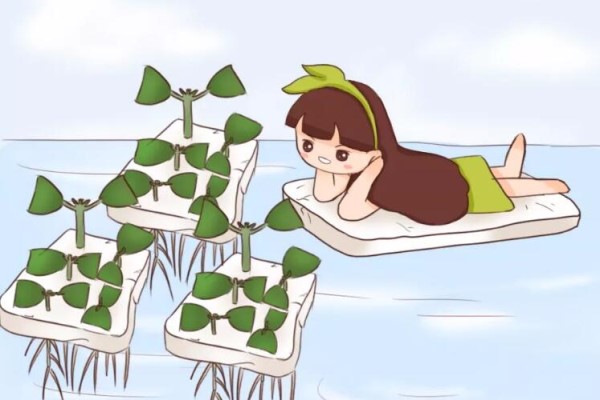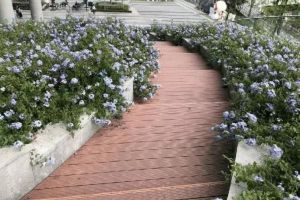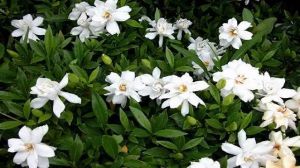Pinch the branches and dip in some water, and the big white roots rub long. This flower is so easy to raise!

The branches of jasmine were thrown into the water, and the white root appeared in 10 days!
The branches of jasmine pruned after flowering in summer are the most suitable for cutting. they not only have a high survival rate, but also take root very quickly.
1. Cut off the flower branches above the jasmine branches, and then cut off the aging branches below. As shown below, only the middle two pairs of bud points and a pair of leaves are retained.
two。 Cut off half of the remaining pair of jasmine leaves, then soak the lower end of the branches in rice vinegar solution (rice vinegar: water = 1: 100) for half a minute and take out. Rice vinegar solution is a self-made rooting agent, which can promote the rooting of branches.
3. Find a foam board, pierce a number of holes, insert the jasmine cuttings into the holes one by one, make sure the foam board leaks out of the bottom of the cuttings by about 2cm, then put the foam on the surface of the water, and it's done!
4. Put the jasmine cutting device in a place with astigmatism and ventilation, change the water frequently, and it can take root in less than half a month.
5. In another 1-2 weeks, the roots of jasmine branches will be quite developed, and it is time to transplant!
6. Choose loose and breathable soil, move jasmine into the soil, pour water, put it in a cool place for 3-5 days, wait until it is rooted, and then bask in a place with good light.
The longevity branches are thrown into the water, and the roots are thick and dense!
Longevity flowers are particularly prone to black rot in summer. In order to prevent longevity flowers from being wiped out, we can cut a few branches for cutting. Not only can we leave a variety, but also the cutting branches will bloom more.
1. With clean scissors, cut off healthy longevity branches and leave them in a cool and ventilated place to dry for half a day.
two。 Find a cardboard, buckle a few holes with a knife, the diameter is smaller than the longevity branch, make sure that the branch does not fall off.
3. Insert the longevity branch into the hole in the cardboard and place it at the mouth of a water bottle filled with water so that the lower end of the longevity branch touches the surface of the water. Circle the body of the water bottle with paper to block out the light.
4. The water in the hydroponic bottle will be changed when it is dirty. In about 2-3 weeks, the branches of longevity flowers will grow into big white roots!
5. When the root system grows more than 3 centimeters, it can be transplanted into the soil.
Gardenia dipped in aspirin will take root twice as fast!
Aspirin is widely used in flower cultivation, especially in promoting rooting, which is better than rooting agent.
1. Cut off the strong branches of the gardenia and remove the leaves at the bottom of the branches.
two。 Prepare an aspirin, crush it, mix it with water 1000 times, mix it into a solution, then soak the gardenia branches in it for 2-3 minutes.
3. Prepare a plastic bottle to be cut from the middle, do not cut it completely, leave a little connection.
4. Find a foam board, cut it into a circle the diameter of a plastic bottle, make a number of small holes, and insert the lower end of the gardenia branch.
5. Fill the lower half of the plastic bottle with water and add foam with gardenia branches to make sure the branches at the bottom of the foam are soaked in water.
6. Cover the upper part of the plastic bottle and tape the cracks in the middle.
7. In this way, gardenia branches in plastic bottles, always in a state of high humidity, will soon take root.
Mint
Summer must grow a pot of mint, can make tea, can cook, 1 pot which can, it is better to pinch a few branches, throw water, take root in a week, want to raise several pots to raise several pots!
1. Cut off several sections of mint branches about 10 centimeters in length to ensure that the branches are healthy, sturdy and free from diseases and insect pests. Make sure there are 2-3 nodes on the branch.
two。 Prepare 1 tablet of vitamin B12, crush it into powder, mix it with water 2000 times, and make a solution. Remove the leaves at the lower end of the peppermint branch and immerse it in vitamin B12 solution for 3-5 minutes. Vitamin B12 solution can promote the rooting of the branch.
3. Insert the treated mint branches into a water bottle and put them in a cool and ventilated place.
4. Adhere to 1-2 days to change the water, less than half a month, peppermint can grow roots!
5. After the root length is more than 3 cm, you can choose to continue hydroponic culture, or you can transplant it into the soil. No matter how many roots you insert, you can basically live.
Throw the copper grass into the water and burst the basin every minute!
The good work of copper grass is well known, especially in summer, when the flood and sun serve you, the pot bursts almost every minute.
1. The leaves of Rabdosia angustifolia can not be used for cutting. what can be used for cutting is its stolon.
two。 Dig up the rhizome of Rabdosia angustifolia, pick a few sections of its stolon, when picking, try to bring leaves and soil.
3. Prepare a shallow dish, fill it with soil at the bottom and water it at the top to form a state of half soil and half water.
4. Take the stolon picked from the grass, bury it in a shallow dish with half soil and half water, and then serve it with a flood and a big sun.
5. If there is no water in the shallow dish, add water in time. As long as there is enough light, a lot of small coppergrass will grow quickly on the stolon. After 3-4 weeks, a small section of stolon will grow into a large pot of it!
Succulent plant
It is difficult for succulent plants to spend the summer, and potted plants are prone to black rot, while the healthy branches left by black rot are not only easy to survive, but also better to spend the summer, and the succulent plants cultivated in soil can also be hydroponically cultivated to spend the summer.
1. Cut off the healthy succulent branches with a sharp cut or hand knife.
two。 Put the cut succulent branches in a place where there is no light and ventilation at home to dry for 2 days.
3. Apply a little rooting agent to the succulent incision and insert it into a glass bottle filled with water to make sure the lower end of the branch is slightly stained with water. Where the light is scattered and ventilated, it can take root within a week in summer.
4. After growing roots, you don't have to rush to soil culture, you can keep them in water until the temperature drops in autumn, and then transplant them to the soil.
5. For those succulent plants that are difficult to spend the summer and easy to black rot, we can also change them from soil culture to hydroponic culture. Hydroponic culture is well ventilated, it is not easy to black rot, and it takes root quickly, so there is no risk.
- Prev

These four kinds of flowers, throwing the green belt can also pop the pot, raising the family will die in 3 days.
Every time I see the green flowers on the side of the road, they are almost jealous! Why do you say that the flowers raised at home are taken good care of every day, either wilting or not blooming, but the flowers in the green belt are almost unattended and bloom more and more? It really pierced the heart of the florist!
- Next

How to raise the lobular gardenia
To raise gardenia microphylla, the soil should be acidic, nutritious, loose and breathable; watering should be judged by the degree of dryness and wetness of the surface soil, and the soil surface can be watered only after the soil surface is dry; fertilization is needed in the growing season; and the illuminance is best controlled at about 60%. In spring, you need to choose whether or not to change the basin according to the condition in the basin. Reproduction can be done by sowing or cutting.
Related
- What if the leaves of potted flowers turn yellow?
- Florescence Control of several Flowers
- Anti-freezing technology and post-freezing nursing technology of flowers
- What is the classification of flowers? What are the common methods of flower classification?
- Prevention and control of alkali and acid damage of flowers in courtyard
- Technology of Anti-freezing and restoring growth of Flower seedlings in greenhouse and greenhouse
- How does flower fertilization not hurt the root? Fertilization technology of flowers
- Key points of disinfection in flower greenhouse
- Several pesticides that are banned or used cautiously in flowers
- How to fertilize the flowers that watch the leaves?

